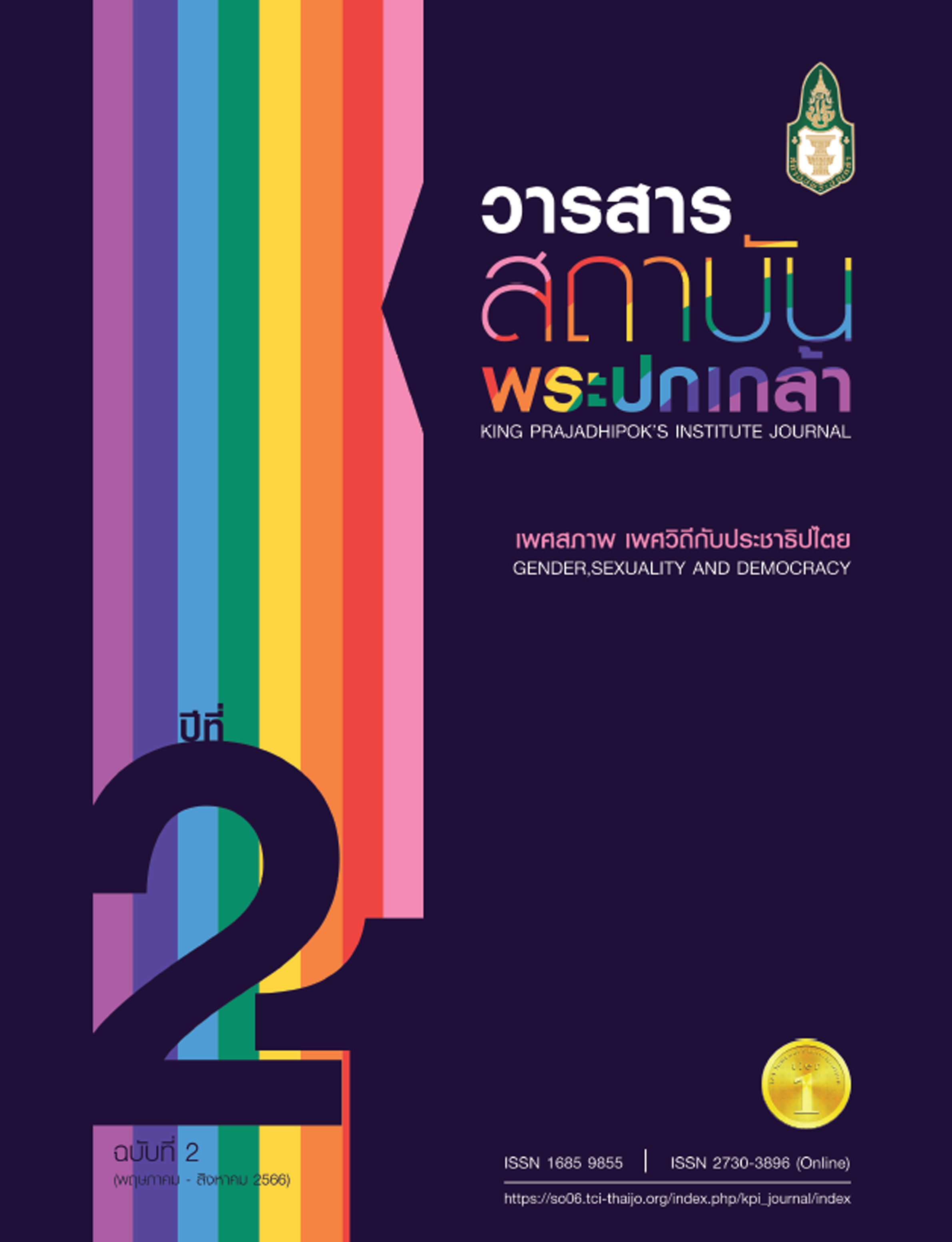Female Revolutionaries of Krungching Area, Nakhon Si Thammarat Province (1972-1982)
Main Article Content
Abstract
This article examines the factors that led women to join the revolutionary movement of the Communist Party of Thailand (CPT) in Krung Ching, Nakhon Si Thammarat province, Thailand, between 1972 and 1982. It investigates the roles played by women within the movement and their experiences after leaving the revolutionary struggle. The study employs document surveys, in-person interviews, and group interviews to gather primary data. The findings reveal that women who joined the movement came from diverse backgrounds, including villagers who received education from CPT members. These individuals faced harassment from government officials and politically conscious students. Within the CPT, women were treated with respect and equality, following the party's principles and guidelines. During their involvement in the movement, women assumed significant roles, which can be classified into two categories: those operating within the village or among the masses and those situated in the camps. Several factors contributed to women's participation in the movement, including engaging in short-term battles, confronting strategic offensives by both the Thai state and international entities, navigating conflicts within the international communist movements, and experiencing the challenges of a failed revolution. The CPT in Krung Ching managed to withstand state repression until 1982 when many participants chose to surrender to the state. Subsequently, women who had been part of the CPT movement in Krung Ching found acceptance within their communities and were able to transfer their acquired experiences and lessons to contemporary societal contexts. Their involvement in the revolutionary struggle provided them with a unique perspective that remains relevant today. This study contributes to a better understanding of women's motivations for joining revolutionary movements, the roles they assume within such movements, and the long-term implications of their participation in post-revolutionary settings.
Article Details

This work is licensed under a Creative Commons Attribution-NonCommercial-NoDerivatives 4.0 International License.
@ 2020 King Prajadhipok's Institute The Government Complex Commemorating All Right Reserved.
References
ภาษาไทย
กลุ่มภูบรรทัด. (2544). บนเส้นทางภูบรรทัด ตำนานการต่อสู้ด้วยกำลังอาวุธของประชาชน. กรุงเทพฯ: อาร์ต เอ็จ กราฟฟิค.
คุณแดง (อดีตสหายหญิง-ชื่อสมมุติ). พิปูน นครศรีธรรมราช. 2556, 21 มีนาคม. สัมภาษณ์.
คุณบัญชา (อดีตสหายชาย-ชื่อสมมุติ). กรุงชิง นครศรีธรรมราช. 2556, 21 มีนาคม. สัมภาษณ์.
คุณปราณี (อดีตสหายหญิง-ชื่อสมมุติ). กรุงชิง นครศรีธรรมราช. 2556, 21 มีนาคม. สัมภาษณ์.
คุณภักดี (อดีตสหายหญิง-ชื่อสมมุติ). กรุงชิง นครศรีธรรมราช. 2556, 21 มีนาคม. สัมภาษณ์.
คุณเรือง (อดีตสหายหญิง-ชื่อสมมุติ). กรุงชิง นครศรีธรรมราช. 2556, 21 มีนาคม. สัมภาษณ์.
คุณวิจารณ์ (อดีตสหายชาย-ชื่อสมมุติ). กรุงชิง นครศรีธรรมราช. 2556, 21 มีนาคม. สัมภาษณ์.
คุณเสี้ยว (อดีตสหายชาย-ชื่อสมมุติ). ท่าศาลา นครศรีธรรมราช. 2556, 21 มีนาคม. สัมภาษณ์.
คุณอรทัย (อดีตสหายหญิง-ชื่อสมมุติ). ท่าศาลา นครศรีธรรมราช. 2556, 21 มีนาคม. สัมภาษณ์.
จิระนันท์ พิตรปรีชา. (2549). อีกหนึ่งฟางฝัน บันทึกแรมทางของชีวิต. กรุงเทพฯ: แพรวสำนักพิมพ์.
ชลธิรา สัตยาวัฒนา. (2544). กรีดแผลกลัดหนอง กรองความจริงโดยผู้หญิง 6 ตุลาฯ. กรุงเทพฯ:
คณะกรรมการรับข้อมูลและสืบพยานเหตุการณ์ 6 ตุลาคม 2519.
เชาว์ พงษ์พิชิต. (2565). ประวัติพรรคคอมมิวนิสต์แห่งประเทศไทย. กรุงเทพฯ: แสงดาว.
ธงชัย นครศิลป์. (2546). สมรภูมิเลือดกรุงชิง. นนทบุรี: ไฟลามทุ่ง.
ธิกานต์ ศรีนารา. (2564). รัก-และ-การปฏิวัติ: การเมืองวัฒนธรรมว่าด้วยความรักของปัญญาชนฝ่ายซ้ายไทยยุคสงครามเย็น. กรุงเทพฯ: สยามปริทัศน์.
บัญชร ชวาลศิลป์. (2546). ดับไฟใต้. กรุงเทพฯ: แสงดาว.
ประจวบ อัมพะเศวต. (2546). พลิกแผ่นดินตอน ขบวนการสังคมนิยมในไทย. กรุงเทพฯ:
สุขภาพใจ.
ฤดี เริงชัย. (2539). หยดหนึ่งในกระแสธาร. กรุงเทพฯ: มิ่งมิตร.
ศิริพร โคตะวินนท์. (2543). ผู้หญิงในขบวนการเคลื่อนไหวของประชาชนชายขอบ: กรณีศึกษาฝายราษีไศล หมู่บ้านแม่มูนมั่นยืน 2 และ 3. (วิทยานิพนธ์มหาบัณฑิต) มหาวิทยาลัย ธรรมศาสตร์, คณะสังคมวิทยาและมานุษยวิทยา. กรุงเทพฯ.
ส.สมพร บี. 3. (สาราณียกร). (2542). ประกายไฟลามทุ่ง อนุสรณ์สถานช่องช้าง สุราษฎร์ธานี. มปพ.
สารูป ฤทธิ์ชู และสุนีย์ ทองไซร้. (2543). ตามรอยช้างแลใต้. กรุงเทพฯ: สำนักงานกองทุนสนับสนุนการวิจัย.
สุชีลา ตันชัยนันท์. (2546). เปิดบันทึกนักโทษหญิง 6 ตุลา. กรุงเทพฯ: คณะกรรมการรับข้อมูลและสืบพยานเหตุการณ์ 6 ตุลาคม 2519.
สุธาชัย ยิ้มประเสริฐ. (2558). น้ำป่า: บันทึกการต่อสู้ในเขตป่าเทือกเขาบรรทัด. กรุงเทพฯ: อ่าน.
สุธาชัย ยิ้มประเสริฐ และคณะ. (2562). ใต้ธงปฏิวัติ ประวัติศาสตร์พรรคคอมมิวนิสต์แห่งประเทศไทยจากคำบอกเล่าของธง แจ่มศรี และสหาย (พ.ศ. 2464-2537). ใน ธง แจ่มศรี ใต้ธงปฏิวัติ: หนังสือที่ระลึกธง แจ่มศรี นักปฏิวัติกรรมาชีพ ผู้ยึดมั่นแนวทางที่ถูกต้องจนสิ้นใจ. มปพ.
สุนี ไชยรส. (2554). เฟมินิสต์ ประชาธิปไตย และสิทธิมนุษยชน: การต่อสู้บนเส้นทางแห่ง
ความเสมอภาค. กรุงเทพฯ: โรงพิมพ์เดือนตุลา.
สุรชัย แซ่ด่าน. (2541). นักโทษประหารคนที่ 310. กรุงเทพฯ: บี.เจ. เพลท โปรเซสเซอร์.
เออิจิ มูราชิมา. (2555). กำเนิดพรรคคอมมิวนิสต์สยาม(พ.ศ. 2473-2479). กรุงเทพฯ: มติชน.
ภาษาอังกฤษ
Chase, M. (2015). Revolution within the Revolution: Women and Gender Politics in Cuba, 1952-1962. USA: University of North Carolina Press.
Judge, SQ. (2020). Women in the Early Vietnamese Communist Movement: Sex, Lies, and Liberation. In Lanzona, VA & Rettig, F (Eds.), Women Warriors in Southeast Asia (pp. 136-157). NY: Routledge.
Khoo, A. (2020). Women Guerrillas of the Communist Party of Malaya: Nationalist Struggle with an Internationalist Experience. In Lanzona, VA & Rettig, F (Eds.), Women Warriors in Southeast Asia (pp. 173-199). NY: Routledge.
Lanzona, VA. (2020). Love and Sex in Time of War and Revolution: Women Warriors in Vietnam and the Philippines. In Lanzona, VA & Rettig, F (Eds.), Women Warriors in Southeast Asia (pp. 200-226). NY: Routledge.
Roberts, RA. (2010). Maoist Model Theatre: The Semiotics of Gender and Sexuality in the Chinese Cultural Revolution (1966-1976). Boston: Brill.
Roy, S. (2012). Remembering Revolution: Gender, Violence, and Subjectivity in India's Naxalbari Movement. India: Oxford University Press.


